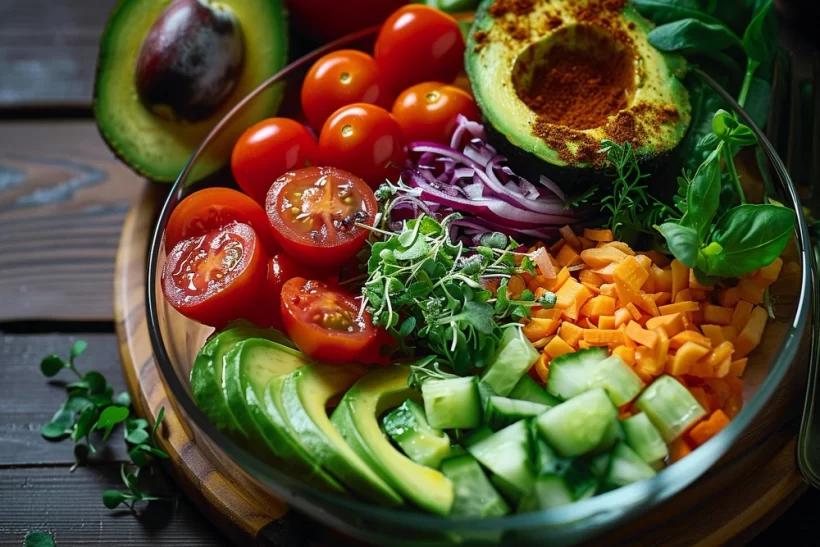Eating Healthy on a Budget: Vegan Edition
Warning: Undefined variable $post in /home/dietofli/public_html/wp-content/plugins/code-snippets/php/snippet-ops.php(584) : eval()'d code on line 3
Warning: Attempt to read property "ID" on null in /home/dietofli/public_html/wp-content/plugins/code-snippets/php/snippet-ops.php(584) : eval()'d code on line 3
The estimated reading time is 6 minutes
Warning: Undefined variable $post in /home/dietofli/public_html/wp-content/plugins/oxygen/component-framework/components/classes/code-block.class.php(115) : eval()'d code on line 3
Warning: Attempt to read property "ID" on null in /home/dietofli/public_html/wp-content/plugins/oxygen/component-framework/components/classes/code-block.class.php(115) : eval()'d code on line 3

Eating Smart and Saving Big
Eating healthy can be a challenge, especially when you're following a vegan diet and trying to keep costs down. Many assume that a plant-based diet is expensive, but with the right strategies, you can enjoy nutritious vegan meals without breaking the bank. This guide will show you how to maintain a healthy vegan diet cost-effectively, providing you with tips, meal plans, and resources to make it easier.
Understanding the Basics
Essential Nutrients for Vegans
Maintaining a balanced vegan diet requires paying attention to essential nutrients. Key nutrients include protein, iron, calcium, and omega-3 fatty acids. Fortunately, there are affordable plant-based sources for each of these.
Protein: Beans, lentils, chickpeas, quinoa, and tofu are excellent and budget-friendly sources of protein. They can be used in various dishes, from soups and salads to main courses.
Iron: Dark leafy greens like spinach and kale, beans, lentils, and fortified cereals are great sources of iron. Pair them with vitamin C-rich foods like tomatoes or citrus fruits to enhance iron absorption.
Calcium: While dairy is off the table, you can get calcium from fortified plant milks, tofu, almonds, and leafy greens. These foods are inexpensive and readily available.
Omega-3s: Flaxseeds, chia seeds, walnuts, and hemp seeds are rich in omega-3 fatty acids. These can be added to smoothies, oatmeal, or salads for a nutrient boost.
Affordable Plant-Based Sources
Understanding where to find these nutrients in affordable plant-based foods is the first step to eating healthy on a budget. Stocking up on staples like beans, lentils, and whole grains ensures you always have the basics for a nutritious meal. Buying these items in bulk can save you even more money.
Planning Meals on a Budget
Weekly Meal Planning Tips
Planning your meals is crucial for staying on budget. Start by making a weekly meal plan that includes breakfast, lunch, dinner, and snacks. This helps you avoid impulse buys and ensures you have everything you need.
Shop in Season: Seasonal produce is often cheaper and fresher. Plan your meals around what's currently in season to save money and enjoy better-tasting food.
Buy in Bulk: Staples like grains, beans, and nuts are cheaper when bought in bulk. Look for bulk bins at your local grocery store or consider joining a bulk food co-op.
Utilize Affordable Staples: Potatoes, rice, oats, and bananas are nutritious, versatile, and inexpensive. Incorporate these staples into your meals to keep costs down.
Creating a Budget-Friendly Shopping List
Once you have your meal plan, create a shopping list. Stick to your list to avoid buying unnecessary items. Prioritize affordable staples and look for sales on fresh produce.
Check Store Flyers: Look at store flyers before heading out to see what’s on sale. Plan your meals around these sales to maximize your savings.
Avoid Processed Foods: Pre-packaged vegan foods can be costly. Focus on whole foods that you can prepare yourself to save money and eat healthier.
Buy Store Brands: Generic or store brands are often just as good as name brands but at a lower price. Don't be afraid to choose these options to save money.
Delicious and Affordable Vegan Recipes
Recipe 1: Chickpea and Vegetable Stir-Fry
Ingredients:
- 1 can chickpeas, drained and rinsed
- Mixed vegetables (carrots, bell peppers, broccoli)
- Soy sauce
- Garlic and ginger
- Rice
Instructions:
- Cook rice according to package instructions.
- In a pan, sauté garlic and ginger until fragrant.
- Add mixed vegetables and stir-fry until tender.
- Add chickpeas and soy sauce, stirring until well combined.
- Serve over rice.
Nutrition Information: High in protein and fiber, this dish is both filling and nutritious.
Recipe 2: Lentil Soup
Ingredients:
- 1 cup lentils
- 1 onion, chopped
- 2 carrots, sliced
- 2 celery stalks, chopped
- Vegetable broth
- Spices (cumin, coriander, turmeric)
Instructions:
- In a pot, sauté onion, carrots, and celery until softened.
- Add lentils, vegetable broth, and spices.
- Bring to a boil, then simmer until lentils are cooked.
- Serve with a slice of whole grain bread.
Nutrition Information: Packed with protein and iron, this soup is a hearty and affordable meal.
Recipe 3: Banana Oatmeal
Ingredients:
- 1 cup oats
- 2 cups water or plant milk
- 1 banana, sliced
- Cinnamon and maple syrup to taste
Instructions:
- Cook oats in water or plant milk according to package instructions.
- Stir in banana slices and cinnamon.
- Drizzle with maple syrup before serving.
Nutrition Information: A great source of fiber and energy, perfect for a healthy breakfast.
Navigating the Grocery Store
Smart Shopping Strategies
Navigating the grocery store efficiently is key to sticking to your budget. Start by shopping the perimeter, where fresh produce is usually located, and avoid the inner aisles filled with processed foods.
Read Labels: Check labels for hidden animal products and unnecessary additives. Stick to simple, whole ingredients.
Find the Best Deals: Look for discounts on bulk items and sales on seasonal produce. Use coupons and loyalty cards to save even more.
Avoid Overpriced Vegan Junk Food: While it's tempting, processed vegan foods like mock meats and cheeses are often expensive and not as nutritious as whole foods.
Utilizing Community Resources
There are many community resources available to help you eat healthy on a budget. Farmers' markets often offer fresh, local produce at lower prices than grocery stores. Food sharing apps can connect you with others who have surplus food to share.
Budget-Friendly Grocery Stores: Look for stores known for their affordability, like Aldi or Trader Joe’s. These stores often have a good selection of organic and plant-based foods at lower prices.
Farmers' Markets: Local farmers' markets are a great place to find fresh, seasonal produce at reasonable prices. Plus, you're supporting local farmers!
Food Sharing Apps: Apps like Olio connect people who have surplus food with those who need it. This is a great way to access free or low-cost food in your community.
Conclusion
Eating healthy as a vegan on a budget is not only possible but also enjoyable. It can be as simple as hiring a scribe from Providers Choice if you plan properly! By understanding essential nutrients, planning meals, shopping smartly, and utilizing community resources, you can maintain a nutritious and cost-effective vegan diet.
Remember, the key is consistency and making informed choices. Try incorporating these tips into your daily routine and see how easy and rewarding it can be to eat healthy without spending a fortune.
Happy eating!














